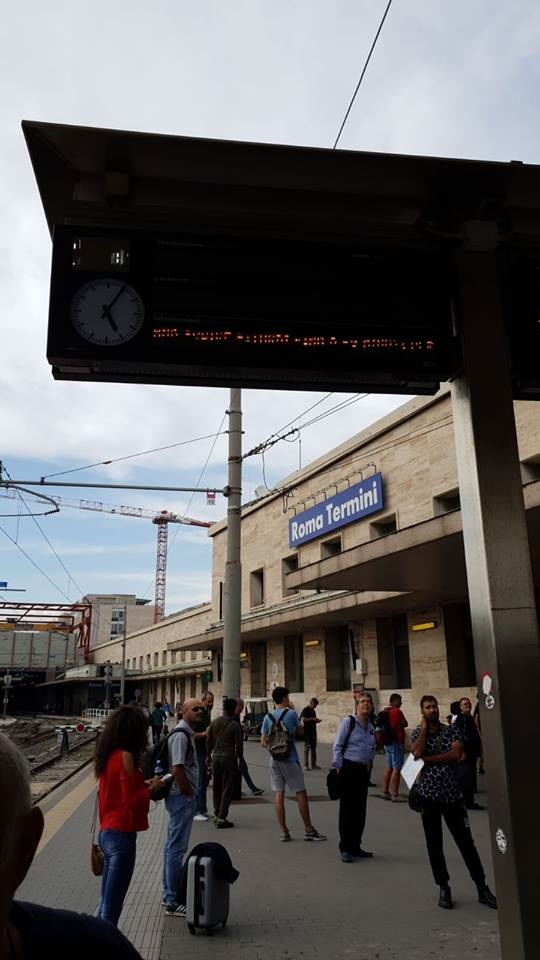Pendolari, cittadini in viaggio con tanti ritardi e l’incubo “linea lenta”, dimenticati un po’ da tutti

La solita odissea dei pendolai ricomincia con l’inizio della settimana. Scorrono i giorni ma i problemi restano costanti. I treni regionali non hanno di certo il percorso e la durata del viaggio. Basta poco, basta un semplice annuncio dalle gracchianti altoparlanti che annuncia laconicamente “oggi il treno verrà instradato sulla linea lenta”. Le facce già stanche per la giornata lavorativa, diventano scoraggiate, “anche oggi si ritorna a casa più tardi”. Partono i soliti messaggi e poi si prova a riposare, sempre che ci si riesca vista l’ergonomia tutta particolare dei sedili.
Il 6 novembre il treno IR4106 delle 17,20 per Firenze è la solito binario nell’area “Est” di Roma Termini pronto a partire, poi l’annuncio che è diventato una sorta di leit motiv temutissimo dai pendolari. E’ così quasi ogni giorno soprattutto per i treni più frequentati e affollati. I pendolari sono al limite della sopportazione nel silenzio più assoluto di chi se ne deve occupare. In Regione spiegano e snocciolano numeri di puntualità e rispetto dei termini del contratto che sulla tratta Orvieto-Roma sembrano lontano. Già, andare sulla linea lenta significa avere un viaggio più lungo e ritardi continui. La domanda che fanno le persone che utilizzano il servizio è semplicissima. perché non ammettere che per percorrere la tratta tra la Rupe e Roma ci vuole più dell’ora e 16 minuti previsti nell’orario ufficiale? Perché si preferisce il ritardo quotidiano o quasi?
I pendolari hanno la sola e costosa alternativa della Carta Tuttotreno e dell’abbonamento InterCity, altrimenti si deve sopportare la linea lenta. I pendolari sono cittadini che chiedono maggiore attenzione perché hanno scelto di continuare a vivere a Orvieto nonostante il lavoro o lo studio a Roma. Hanno scelto di “allungare” il loro orario di lavoro di circa tre ore al giorno per vivere, spendere, pagare le tasse a Orvieto e non a Roma o magari, a Orte. A quando un intervento più determinato? Quando si farà pesare la posizione di Orvieto, posto sulla direttissima, quasi unico comune in Umbria, ma snobbato per l’eventuale collegamento veloce con Roma e Milano preferendo stazioni fuori Regione? Quando una protesta formale visto che, sempre secondo quanto riferito dai pendolari, altri treni di pari categoria diretti verso altri comuni, ad esempio Foligno, non devono subire quasi mai la stessa sorte della linea lenta?
Intanto per i pendolari, oltre un migliaio, i risultati concreti soon un peggioramento evidente della qualità della vita, tante ore di mancata vita sociale e familiare e stress perché non si sa mai a chi rivolgersi per una protesta formale se non al solito call center…e intanto le ore effettive di viaggio crescono.
ENGLISH VERSION
COMMUTERS, TRAVELING CITIZENS FACE WIDESPREAD DELAYS AND THE NIGHTMARE OF THE “SLOW LINE”, SOMEWHAT FORGOTTEN BY ALL
The usual odyssey of commuters begins anew with the start of the week. The days go by, but the problems remain constant. Regional trains certainly don’t have the route and travel duration. It takes very little, just a simple announcement from the crackling speakers that laconically declares, “today the train will be routed on the slow line.” The already tired faces for a day’s work become disheartened, “once again, we’re returning home later today.” The usual messages start, and then an attempt to rest is made, provided one can actually achieve it given the unique ergonomics of the seats.
On November 6th, the 17:20 IR4106 train to Florence is on the usual track in the “East” area of Rome Termini ready to depart, then comes the announcement that has become a dreaded leitmotif for commuters. It’s like this almost every day, especially for the most frequented and crowded trains. Commuters are at the limits of endurance in complete silence from those who are supposed to address it. In the region, they explain and provide numbers of punctuality and contract compliance that seem distant on the Orvieto-Rome route. Indeed, taking the slow line means having a longer journey and constant delays. The question that those who use the service ask is very simple: why not admit that it takes more than an hour and 16 minutes as indicated in the official timetable to cover the stretch between Orvieto and Rome? Why is daily or near-daily delay preferred?
Commuters have the expensive and sole alternative of the Carta Tuttotreno and the InterCity subscription; otherwise, they must endure the slow line. Commuters are citizens who demand more attention because they have chosen to continue living in Orvieto despite their work or studies in Rome. They have chosen to “extend” their daily working hours by about three hours to live, spend, pay taxes in Orvieto, and not in Rome, or perhaps in Orte. When will a more determined intervention take place? When will Orvieto’s position, located on the direct route, be taken into account? It is almost the only municipality in Umbria but is ignored for a fast connection with Rome and Milan, preferring stations outside the region. When will a formal protest take place since, as reported by commuters, other trains of the same category bound for other municipalities, such as Foligno, rarely have to suffer the same fate as the slow line?
Meanwhile, for the commuters, over a thousand of them, the concrete results are a clear deterioration in their quality of life, many hours of missed social and family life, and stress because it’s never clear who to turn to for a formal protest other than the usual call center… and in the meantime, actual travel hours increase.